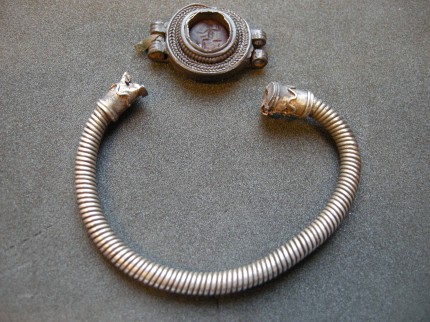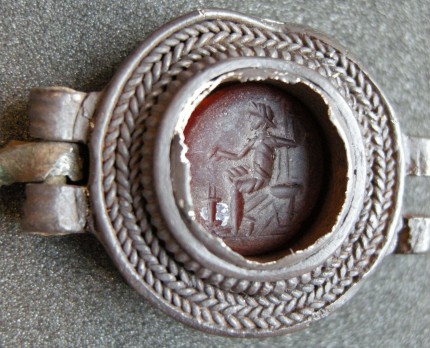
On July 26th, 2012, a metal detectorist found a Roman bracelet near Dalton, Cumbria, northwestern England. It was broken in two pieces: a twisted tube made out of spiralled silver wire and a hinged round bezel with a red gemstone intaglio of Jupiter. Dating to the 2nd or 3rd century A.D., this bracelet is a very rare artifact, especially so for the Furness area because no Roman structures have ever been found there. Plenty of Roman coins have been, but not high-end jewelry like this piece. The artifact thus testifies to the wide range of Roman trade reaching the ends of the empire, or it may point to a settlement that hasn’t been unearthed yet.
The finder reported it to the Portable Antiquities Scheme liaison and the subsequent coroner’s inquest declare it official treasure trove. Since then, the bracelet has been at the British Museum where experts were studying it and assessing its market value so a local museum, in this case the Dock Museum in Furness, could acquire it. The price was modest compared to some of the major treasure finds — just £1,800 ($3,000) — but small local museums don’t have acquisition budgets so they had to raise the funds.
Thanks to a donation from the Furness Maritime Trust, the Dock Museum is now the proud owner of this beautiful and rare piece of jewelry. It will go on display on March 14th in the museum’s new archaeology gallery. There will be associated workshops at the end of the month that schools have been invited to, and on Saturday, April 12th, a free Roman-themed family fun day.
It’s only fair that such a handsome piece of jewelry would inspire all kinds of new exhibitions and events at the museum. I think the striking spiral wire design with filigree terminals is reminiscent of a torc while the intaglio is a Greco-Roman classic. That’s not to say this was a hybrid of British and Roman workmanship. The thick spiral-twisted wire band with elaborate terminals and an engraved gemstone set in hinged bezel center is a design that has been found far, far away from Britannia. A similar silver hinged bracelet was found in Slovenia. Gold examples have been found in Syria and Egypt. This was an import, and an expensive one at that.
From the curator’s report for the treasure inquest:
The distorted elliptical hoop comprises a fine and evenly-twisted, tightly-spiralled tube made from circular-sectioned silver wire. Quite heavy wear is visible on both sides of the hoop. What appears to be the central core, around which the wire was spiralled, is visible under magnification in those places where distortion has slightly ‘opened’ the twisted strands, but its composition is uncertain. Each terminal is enclosed in a tubular collar which is decorated with an applied central meander filigree wire flanked by a double-ring edge-moulding. […]
The large circular bezel, a hollow box construction of silver sheet, has a plain back and sides. Its ornate upper face comprises an outer basal zone of herringbone pattern, formed from three concentric circles of twisted wire, and a central raised open dome with ribbed side and stepped, apparently rubbed-over, setting. The oval gem, seemingly of translucent orange-red colour, has dropped out of position to the base of the box-setting, presumably as a result of the deterioration and loss of an original organic packing. Engraved into its lightly convex surface is the image of a seated Jupiter, with wreath and full-length drapery, holding a sceptre in his left hand. In his extended right hand he holds a patera above a stylised flaming altar.
Whoever owned this bracelet had to be very wealthy. Dock Museum curator Sabine Skae speculates that it belonged to a wealthy Furness woman, native rather than Roman, who could afford the best and wanted to show it off.
